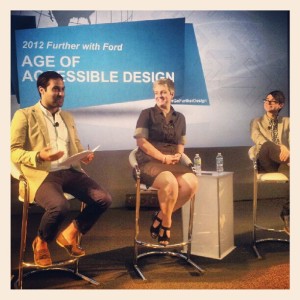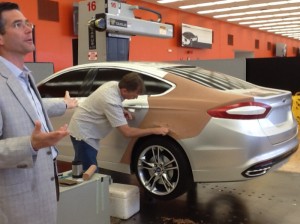I got to attend an event sponsored by Ford last week in Detroit. They hosted more than 250 bloggers to hear their take on trends in the car industry. I came as someone who is not much of a car nut, but interested in what they had to say.
Some brief personal history: I have owned less than five cars in my life, buying my first car at age 30 when I move to Los Angeles. For most of my life, I have shared a car with my wives (I know that sounds funny but anyway), and have lived in areas that rate high on the WalkScore.com scale. More on that in a moment.
Over the past several years, I have driven several Fords as part of their press reviewer program, and indeed this experience got me to buy my current car, a Lincoln MKZ.
At the event, we heard from Bill Ford, the great-grandson of Henry and board chairman. I came into this session with a very cynical attitude and came away very impressed with his down-to-earth, matter-of-fact manner. Bill Ford isn’t trying to take over other transportation modes but cooperate and indeed layer cars on top of them and encourage more multi-modal travel. For those of us that live in urban areas, this is basicall how we live our lives. When I have to go to the airport, I try to take our light rail line. When I have a meeting that is less than 5 miles away, I try to bike or use transit. Or schedule meetings that are in walking distance of my office.
While coopetition is the natural way of the IT world, it was nice to see it coming from such an old industry as cars. Bill Ford said he has been an environmentalist since 1979, and wants to make small, efficient cars fun to drive and compelling outside of their green cred. That makes sense to me. Ford was one of the first companies toput lots of tech into the lower-end models, and still does. Yes, you can buy a fancier infotainment system from BMW and Mercedes, but that isn’t the point. Ford combines small cars loaded with technology, and deliberately so.
It also seems that Bill Ford is trying to be the Mark Zukerberg of the mobility industry. Or maybe the other way around. Both want to provide more tools to make the experience (driving, networking) easier, cheaper and more ubiquitous.
Part of this democratization is taking a new turn. In the post-war era when I (and the rest of the boomers) was born, that meant buying a house in the suburbs and buying at least one if not two cars. That model is officially over. Today, the cool GenY kids are moving near the central business district (CBD) of urban areas. It isn’t the picket fence that is important, but being closer together.

Ford demo of its biometric real-time analyzers at their R&D center. You can see heart and respiratory monitors on screen.
At the conference, we heard some interesting stats. In 1980, young people were 10% more likely to move near CBDs. Now GenY is 42% more likely to be near the CBD. If they have graduated college, even more so. Gen Y is getting their driving licenses later and driving fewer miles. They are putting more money into technology and replacing car trips with online socializing.
Clearly, cities are attracting smarter and younger people.
Why is the CBD attractive? It is because they have access to more stuff to do, and that stuff attracts more and younger and better-educated people to live there. “Stumble on to the fun” is the concept that I heard at the Ford conference from urbanist Carol Coletta.
People are choosing to be closer to where they shop, eat, and entertain themselves. It is a powerful motivation. There is research to show that people are paying a premium to live in these more walkable neighborhoods. I am one of them.
The website WalkScore.com has attempted to quantify this by rating your address by how close you are to that stuff. If you haven’t seen this, you can go over there now and get your rating. Mine is 86 or “very walkable.”
But what does this to do with anything? Having this influx of talented young folks help to drive a higher quality of life and in turn helps to attract and create more jobs.
The idea of doing “buffalo hunting” by cities – looking for big employers to bag and bring to their areas—is passe. I attended a press conference last week at our mayor’s office where he celebrated adding 25 new jobs from 15 startup companies who are moving into the CBD of St. Louis. Think about that – in years past he probably wouldn’t have taken a phone call from any of the entrepreneurs that were standing up with him at the event. Our mayor, like many, realizes that making these entrepreneurs succeed will bring more jobs and more smart people into town.
Just as this represents a big sea change for economic development and city planning, it also is a big change for corporate America, such as Ford. Look how far they have come in the 100 years since Henry first started building cheap cars for Everyman.
Back then Ford enabled the suburbs by making these cheap cars. But that doesn’t fly now. They have to make the cheap cars fun to drive. “We want to offer a premium experience to the mainstream customer,” said one Ford executive. Call it the democratization of design. Why is Martha Stewart doing products in Target, and $30 Payless shoes being designed by mainstream designers like Christian Siriano?
Ford is no longer “just” a car company, but a full-service mobility provider. It was exciting to see some of this at their event. Here are some of the photos that I took during the trip.


Pingback: The return of the American Industrial Revolution | David Strom's Web Informant